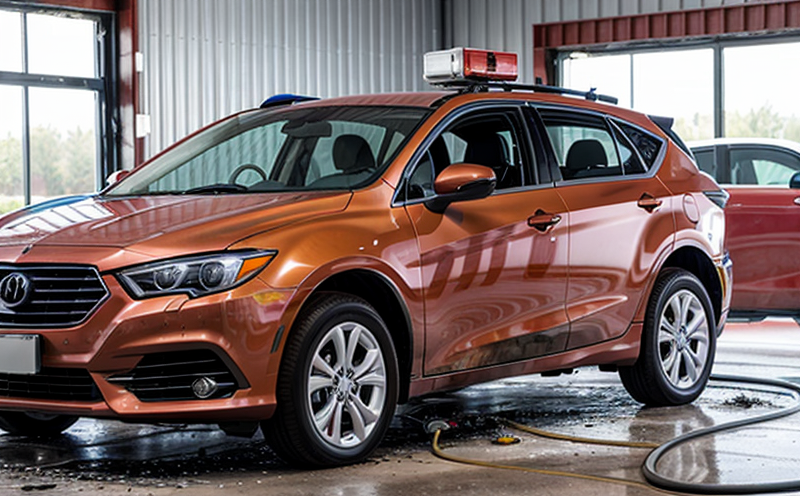Fire Safety Testing of Sun Visors and A-Pillars
The automotive industry is highly regulated with respect to fire safety. Ensuring that components such as sun visors and A-pillars meet stringent fire safety standards is critical for maintaining compliance, enhancing passenger safety, and protecting the integrity of vehicles during a fire event.
During fires within or near automobiles, these components can be subjected to extreme temperatures, flames, and thermal stresses. Therefore, it's essential that they are designed and manufactured in such a way that they do not contribute to the spread of fire or compromise structural integrity. Fire safety testing is an integral part of this process.
Our laboratory specializes in providing comprehensive fire safety testing for sun visors and A-pillars. This includes understanding the specific challenges these components face during fires, designing appropriate test methods, and ensuring that the tests are conducted under realistic conditions to reflect real-world scenarios.
The tests we perform focus on assessing the ability of sun visors and A-pillars to withstand high temperatures without catching fire or releasing toxic fumes. This involves exposing the specimens to controlled fire environments where their performance is monitored over time. Our testing protocols align with international standards such as ISO, ASTM, EN, IEC, etc., ensuring that our findings are recognized globally.
Our expertise in this area allows us to offer not only standard tests but also customized solutions tailored to specific client needs. This could involve testing different materials, evaluating the effectiveness of fire-resistant coatings, or assessing the impact of various environmental factors on performance. Our team is dedicated to providing accurate and reliable data that can help our clients make informed decisions regarding their product designs.
To ensure consistent quality across all tests, we use state-of-the-art equipment and adhere strictly to international standards. This commitment ensures that every test conducted at our facility meets the highest industry benchmarks, giving you peace of mind knowing that your products have been thoroughly evaluated for fire safety.
Scope and Methodology
| Test Procedure | Description |
|---|---|
| ISO 17034:2016 | General requirements for the competence of testing laboratories. |
| ASTM E955-18 | Determination of flame spread and smoke production characteristics of materials using a small-scale burn test apparatus. |
| EN 1367:2004 | Fire tests for building products and elements - Determination of the fire resistance of doors, windows and shutters by means of standard fires. |
| IEC 60335-2-89 | Particular requirements for electrical equipment in vehicles, including safety aspects related to components used in the interior of motor vehicles. |
The scope of our fire safety testing includes both static and dynamic tests. Static tests involve holding the specimen under a defined flame until it stops burning or reaches a predetermined temperature. Dynamic tests simulate real-world conditions by subjecting the component to simulated vehicle movements while exposed to flames.
For sun visors, we focus on evaluating their ability to remain intact when exposed to direct flame contact and radiant heat from nearby fires. For A-pillars, our testing ensures that these critical structural components maintain their integrity under severe thermal conditions without compromising safety.
Benefits
- Enhanced Product Safety: Ensures compliance with international fire safety standards.
- Informed Decision-Making: Provides accurate and reliable data to support design modifications.
- Increased Market Confidence: Demonstrates commitment to passenger safety, attracting more customers.
- Reduced Risk of Liability Claims: Minimizes potential legal issues associated with product failures during fires.
- Competitive Edge: Differentiates your products from competitors who may not adhere to strict fire safety protocols.
- Simplified Regulatory Compliance: Streamlines the process of meeting government regulations related to fire safety.
- Cost Savings: Identifies and rectifies potential issues early in the development cycle, reducing rework costs.
Competitive Advantage and Market Impact
By incorporating rigorous fire safety testing into your product development process, you can gain several competitive advantages. First, it enhances brand reputation by showing a strong commitment to passenger safety. Second, it helps in gaining market share as consumers increasingly prioritize products that meet high safety standards.
The results of our tests provide valuable insights that can influence design decisions, leading to improved product performance and durability. This not only benefits your company but also contributes positively towards overall industry advancement by setting higher benchmarks for fire safety within the automotive sector.
Moreover, compliance with international regulations opens up new markets where similar standards are enforced. It allows you to expand into regions like Europe (EN), North America (ASTM), and Asia-Pacific countries that have stringent fire safety requirements.





